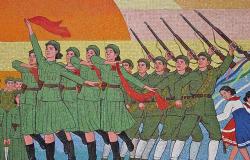Assessing North Korea’s Danger

Toro Hardy explores the plausible reasons behind North Korea’s recent aggressive deeds and words.
Inter-Korean relations, which have been in a spiraling down trend since 2020, have dramatically nosedived these last few months. The actions taken by Pyongyang have caused generalized alarm. These include the launching of a military satellite, an intercontinental ballistic missile (ICBM) test, the testing of an underwater nuclear drone, a submarine launched cruise missile test, and an artillery barrage that fired 350 rounds near a disputed maritime border with South Korea in the West Sea. Meanwhile, Kim Jong Un’s statements and rhetoric disavowing reunification with South Korea and threatening its southern neighbor have skyrocketed.
Indeed, abandoning the longtime official goal of peaceful reunification, the latter is now being called not only a “foreign” state”, but North Korea’s “number one hostile country”. While issuing new threats of war with South Korea, Kim is denying the kinship between the two countries, referring to them as “belligerent states in the midst of war”. At the same time, he has instructed that conciliatory references to unity must be removed from the Constitution, and that the armed forces must prepare “for a great event to suppress the whole territory of South Korea” (Sue, 2024).
Top experts’ interpretations of North Korea’s deeds and words, substantially differ. For some, the Korean Peninsula is at the brink of a new war. For others, we are just witnessing pressure politics as usual, aimed at influencing the outcome of elections in Seoul and Washington. A third perspective visualizes North Korea’s emboldened attitude, within the context of its insertion into a revisionist axis of nations. A brief overview of these positions, may help understanding where things stand.
Armageddon in view?
Robert L. Carlin and Siegfried S. Hecker, two well-known scholars and practitioners with top expertise on Korean affairs, have concluded that the situation in the Peninsula is at its most dangerous point since early June 1950. Believed to have exhausted all other options, particularly the central goal of normalizing relations with the United States which prevailed between 1990 and 2019, Kim Jong Un has made the strategic decision to go to war. In Pyongyang’s view, successive American administrations pulled away from engaging with it, and ignored North Korea’s constructive initiatives. The straw that broke the camel’s back came with Kim’s perception of having poured his prestige into the second summit with President Trump in Hanoi, to no avail. Moreover, he feels that he was left in the lurch, in a loose-faced position. The belief that there is no way further with the United States, is compounded by the conviction that America is in global retreat. North Koreans seemed to be specially fixated on the U.S. military’s departure from Afghanistan in August 2021 (Carlin and Hecker, 2024; Wong and Barnes, 2024).
The idea of a surprise attack, able to “knock the Americans mentally off-balance, knock everybody off-balance”, has taken ground within Pyongyang’s military. In Carlin and Hecker’s own words:
“North Korea has a large nuclear arsenal, by our estimate of potentially 50 or 60 warheads deliverable on missiles that can reach all of South Korea, virtually all of Japan (including Okinawa) and Guam. If, as we suspect, Kim has convinced himself that after decades of trying, there is no way to engage the United States, his recent words and actions point toward the prospects of a military solution using that arsenal” (Carlin and Hecker, 2024).
Tilting elections result
At the other extreme of this highly alarmist perspective, is the interpretation of Pyongyang’s actions and rhetoric given by Tae Yong-ho. As a lawmaker from the South Korea’s ruling People Power Party, and a former North Korean diplomat who defected to the South in 2016, his voice on these matters seems authoritative enough. In his view, Kim Jong Un is simply trying to induce more palatable results in South Korea’s general election and in the U.S.’ presidential election, both to be held in 2024. Accordingly, the North is attempting to tilt the results of South Korea’s April election in favor of the opposition Democratic Party, which has traditionally been more dovish and cooperative toward Pyongyang. Meanwhile, it is sending a message to American presidential candidates that the time has come to renegotiate one-on-one with North Korea, as it now possesses missiles capable of reaching the U.S. mainland. Simultaneously, Kim is laying the groundwork for Trump’s victory, as he not only developed a more personal relationship with him but perceives him to be more amenable in relation to the possibility of a positive shift in America’s long-standing North Korean policy (Kenji, 2024).
Hence, while for Carlin and Hecker nuclear apocalypse approaches, Tae Yong-ho talks about pressure politics as usual. It is difficult to believe that Kim Jong Un will be willing to risk the total annihilation of his country, because negotiations with Washington have stalled. However, that a fundamental strategic shift on North Korea’s long-standing policy towards the South mainly aims at influencing electoral outcomes, looks out of proportion. Less ominous than the first scenario, but more systemic than the second, is the perspective provided by Jonathan Corrado, Policy Director at New York City’s Korea Society.
The revisionists axis
According to him, competing geopolitical blocks are consolidating, with a revisionist one opposing the rules-based order. This represents a big shift in relations from 2016 and 2017, the high-water mark for international cooperation. During those years, “North Korea’s dangerous aggression” was sanctioned by United Nations Security Council’s resolutions, supported by both Russia and China. The current situation, on the contrary, foretells “North Korea’s emergence out of the shadows, shielded by a patchwork of revisionists allies”. Russia’s invasion of Ukraine has resulted in Moscow and Pyongyang mutually scratching their backs, with an interchange of artillery shells and antitank missiles for advanced satellite and military technology. Not surprisingly, North Korea feels increasingly emboldened within this emerging state of things (Corrado, 2023).
Corrado’s perspective is in tune with the notion that strongman politics is again ascendant among the world’s great powers. In Hal Brands words: “First, the Pax Americana of the post-Cold War period is over. For a generation after 1991, the world saw historically low levels of geopolitical and ideological competition, mostly because Washington and its allies had such a decisive advantage. That’s changing as revisionist actors, principally China, Russia and Iran, try to throw back American power and create their own spheres of influence. The resurgence of autocratic great powers, in turn, is intensifying (…) Second, connections between revisionists actors are stronger that at any time in decades” (Brands, 2023).
Flexing its muscles
Within this scenario, North Korea is finding a comfortable geopolitical space. Moreover, what used to define this country as a pariah within the international community, now translates into its entry ticket and power ranking status within the revisionist axis. The potentially 50 or 60 nuclear warheads deliverable on missiles, mentioned by Carlin and Hecker, would certainly place Pyongyang as one of the top players within this axis’ ranking. Specially so, if its Hwansong-18 intercontinental ballistic missile, tested last December, shows capable of reaching any part of the continental United States.
It has been argued that striking similarities exist between the emergence, interlinked relations and solidarity of the totalitarian regimes of the 1930s and today’s revisionist block (Brand, 2024). If so, the possibility of a World War III looming in the air cannot be ignored. However, there is a long haul between that and the Korean Peninsula’s imminent Armageddon with nuclear reverberations reaching Japan and Guam, as predicted by Carlin and Hecker.
The current noise emanating from Pyongyang is perfectly in line with the muscle flexing typical of strongman regimes. Specially so, when asserting their position within their own flock and in relation to a competing one. This may include, but is far from being limited to, pressure politics aimed at electoral purposes. More adroitly, one of its objectives may be messaging North Korea´s new standing as a world power within the nascent geopolitical correlation.
Alfredo Toro Hardy, PhD, is a retired Venezuelan career diplomat, scholar and author. Former Ambassador to the U.S., U.K., Spain, Brazil, Ireland, Chile and Singapore. Author or co-author of thirty-six books on international affairs. Former Fulbright Scholar and Visiting Professor at Princeton and Brasilia universities. He is an Honorary Fellow of the Geneva School of Diplomacy and International Relations and a member of the Review Panel of the Rockefeller Foundation Bellagio Center.
Image: Mark Fahey via Wikicommons Creative Commons Attribution 2.0
References
Brands, Hal (2023). “Hamas Consigns the Pax Americana to History Books”, Bloomberg, October 9.
Brands, Hal (2024). “The Next Global War”, Foreign Affairs, January 26.
Carlin, Robert L. and Hecker, Siegfried S. (2024). “Is Kim Jong Un Preparing for War?”, 38North, January 11.
Corrado, Jonathan (2023). “North Korea’s Coming Breakout”, War on the Rocks, September 12.
Kenji, Yoshida (2024). “Tae Yong-ho on North Korea’s Purposeful Aggression”, The Diplomat, January 13.
Sue, Mi Terry (2024). “The Dangers of Overreacting to North Korea’s Provocations”. Foreign Affairs, January 30.
Wong, Edward and Barnes, Julian E. (2024). “U.S. Is Watching North Korea for Signs of Lethal Military Action”, The New York Times, January 25.


